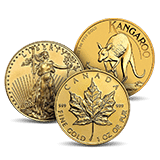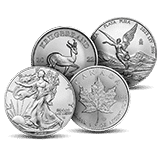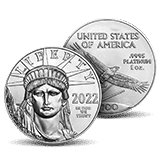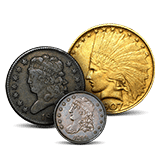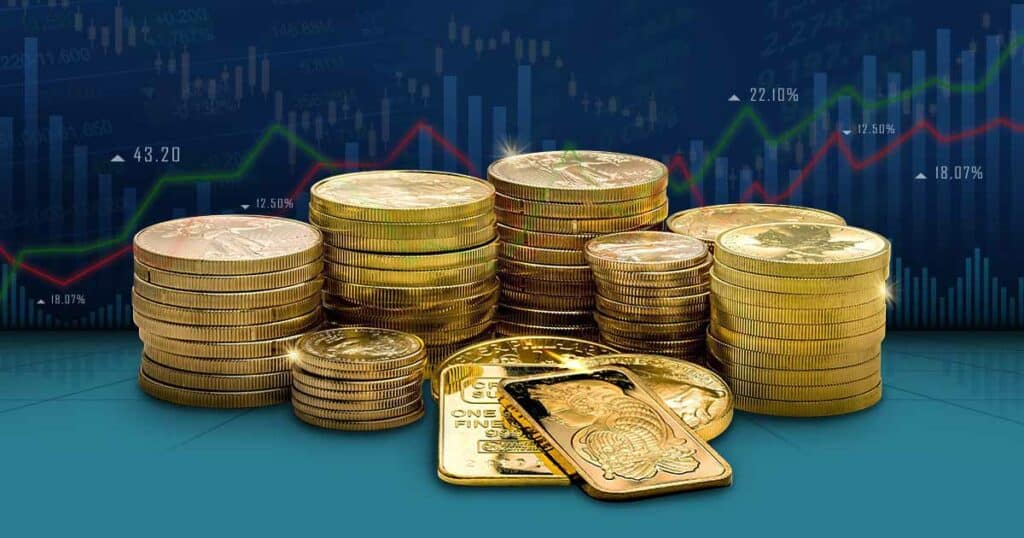
Exchange Traded Funds (ETFs) are a popular investment tool for various asset classes, including precious metals. Precious Metals ETFs allow investors to gain exposure to precious metals’ price movements without having to physically manage the bullion.
Precious Metals Exchange Traded Funds (ETFs) are a subset of ETFs that focus on investing in precious metals, either directly or through various derivatives. These metals typically include gold, silver, platinum, and palladium.
Advantages of Precious Metals ETFs
Investing in physical metals (like gold or silver bullion) and metal-based Exchange Traded Funds (ETFs) both have their merits, but they serve different purposes and come with distinct advantages and disadvantages.
Liquidity
Like other ETFs, precious metals can be traded on stock exchanges, offering liquidity like stocks.
Ease of Access
You can gain exposure to precious metals without dealing with the complexities and security concerns of storing physical metals.
Diversification
Precious metals can be a diversification tool, as they often do not correlate with other financial assets like stocks or bonds.
Tangible Asset
Physical metal is a tangible asset. This tangibility can give you a sense of security, knowing you own a physical good rather than a paper asset.
Less Counterparty Risk
When you own physical metal there is a lower counterparty risk, such as a bank failure.
Low Management Fees
While costs are associated with storing and insuring physical metals, the fees are usually just a percentage of the value of your holdings.
Avoidance of Forced Liquidation
In the case of extreme market volatility, some financial instruments or products can be subjected to forced liquidation. Owning physical metal allows you to avoid such situations.
Safeguard Against Electronic or Cyber Failures
Physical metals, since they are a physical asset, are immune to electronic glitches, hacking, or cyber-attacks, which could affect your digital or electronic financial assets.
Precious Metals ETFs vs Other Investment Types
When comparing precious metals EFTs to other types of investments, you will benefit from comparing their most salient pros and cons. Most investors diversify and invest in multiple types of investments. Before adding to your portfolio, it is important to speak with your financial advisor before making large investments.
| Pros | Cons | |
| Precious Metals | Diversification, Liquidity, Lower Cost | Volatility, No Dividend Payments |
| Stocks | Growth Potential, Dividend Income | Volatility, Requires Research |
| Bonds | Steady Payments, Lower Volatility | Interest Rate Changes, Limited Growth |
| Real Estate | Tangible Asset, Rental Income, Tax Benefits | May Take Time to Sell, Requires Capital, Maintenace |
| Mutual Funds | Diversification, Professional Management | Fees, Potential Underperformance |
| Cryptocurrencies | Potential Returns, Decentralization | High Volatility, Regulatory Concerns |
Types of Precious Metals ETFs
There are three types of precious metal EFTs. One ETF type involves investing in physical bullion, whereas the other two do not.
Physical ETFs
These ETFs hold the actual precious metal, like gold or silver, in vaults. An example is the SPDR Gold Trust (GLD), which holds physical gold.
Futures-Based ETFs
These ETFs do not hold physical metal. Instead, they invest in futures contracts for the metal. This may introduce risks, such as the potential impact of contango or backwardation on the futures curve.
Stock-Based ETFs
Instead of holding the metal or its futures contracts, these ETFs invest in the stocks of companies that are involved in the mining, refinement, and production of precious metals.
Large Volume Precious Metals ETFs
This is not an exhaustive list of EFTs. It is just a sampling of many. While some EFTs focus on one metal, others offer EFTs for more than one metal, including copper and nickel.
- Gold: SPDR Gold Shares (GLD), iShares Gold Trust (IAU), abrdn Physical Gold Shares (SGOL)
- Silver: iShares Silver Trust (SLV), Sprott Physical Silver Trust, abrdn Physical Silver Shares ETF (SIVR)
- Platinum and Palladium: abrdn Physical Platinum Shares EFT (PPLT), abrdn Physical Palladium Shares (PALL), Granite Shares Platinum Trust (PLTM)
- Diversified: Some ETFs track a basket of precious metals. For instance, Sprott ETF and abrdn Physical Precious Metals Basket Shares ETF (GLTR) offer investment opportunities for multiple precious metals.
Comparing Precious Metal ETFs
When reviewing EFTs, remember that current or past performance may differ from your experience. As you know, the precious metals market is constantly adjusting. Many will show their 1-year, 5-year, and since inception performance numbers, but that does not mean you will experience those returns.
When researching, you will come across some common terms such as,
Fund Value
The fund value is simply the current value of the assets managed. As the market fluctuates, the value may as well.
YTD or 12 Month Average Return
Most EFTs communicate their YTD revenue average expressed as a percent. Others may only provide 12-month average return information.
Expense Ratio
The expense ratio indicates the operational costs incurred by an investment firm to manage your ETF, represented as a percentage of the fund’s average total assets. This percentage is subtracted from the ETF’s assets each year. Typically, this figure falls within the 0.XX% range, with an average of around 0.65%.
Premium Discount
When the market price of the ETF is higher than the Net Asset Value (NAV), the ETF is said to be trading at a “premium.” Investors are paying more for the ETF than the intrinsic value of its underlying assets. If the price of the ETF is trading below its NAV, the ETF is trading at a “discount.”
Vault Location
When purchasing precious metal bullion, you should know where your assets are held and secured. Most EFTs do not hold the precious metals themselves. They partner with banks or other secure facilities to manage inventory and shipments. Of the ten we looked at, all were not in the U.S. If you want your precious metals to be located in your home country, that may be something to consider. We have vault options within the U.S.
About JPMorgan Chase Bank, N.A
You may notice that many EFTs use JPMorgan Chase Bank, N.A. to store, secure, and manage bullion assets. It is one of the world’s largest and most prominent financial institutions. It is part of JPMorgan Chase & Co., a multinational banking and financial services holding company. While headquartered in New York City, JPMorgan Chase operates in numerous countries around the globe.
Indexes
Most EFTs publish what index they follow to determine precious metals’ value.
LBMA (London Bullion Market Association)
The LBMA is an international trade association representing the London gold and silver bullion market. The LBMA sets and promotes quality standards for gold and silver bars. The Association’s key role is to oversee the London Good Delivery List, widely recognized as the benchmark standard for gold and silver bars globally.
Dow Jones Precious Metals Index
The Dow Jones Precious Metals Index is a subset of the Dow Jones U.S. Indices. It is designed to track the performance of companies involved in mining and production of precious metals, including gold and silver.
S&P GSCI (Goldman Sachs Commodity Index)
This sub-index focuses on precious metals. Historically, the main components have been gold and silver. The index can be used as a benchmark for performance, as an underlying index for financial products (like ETFs or futures contracts), or as a guide for making asset allocation decisions in the commodities space.
EFT Cost Considerations
Beyond the cost of the investment, there are other associated costs to consider. There are some costs that may be required to manage your account, store and transfer your bullion, and brokerage fees when buying or selling. Sometimes the fees may be rolled into the expense ratio, other times it may be a separate expense.
Expense Ratio
The expense ratio is a measure of what it costs for an investment company to operate your ETF. It is expressed as a percentage of the fund’s average assets under management. That amount is deducted from your fund’s assets usually annually. The amount is usually in the range of 0.XX%, on average of about .65%.
Tracking Error
Tracking error measures the standard deviation of the difference between an investment’s returns and its benchmark index’s returns. It quantifies how much the performance of the investment deviates from the performance of its benchmark.
Storage Fees
Physical ETFs may have associated storage fees that can erode returns over time. There may also be fees for managing your physical gold or shipping and handling costs if you buy or sell your bullion.
Tax Implications
Depending on the state, the gains from selling precious metals ETFs might be subject to a higher tax rate than long-term capital gains on stocks.
Possible Risks
The performance of your precious metals EFTs may be impacted by numerous factors, including economic downturns, geopolitical tensions, inflation fears, and central bank activities. Always make sure to do thorough research and consult with a financial advisor before making an investment decision.
Price Volatility
Precious metals can be volatile, with prices influenced by global economic conditions, interest rates, and supply-demand dynamics.
Counterparty Risk
This is a concern with futures-based ETFs where there is a risk that a party involved in the ETF might default on its obligations.
Impact of the Futures Curve
Futures are not connected to physical metals. This could lead to risks, including the effects of contango or backwardation on the futures price curve.
OneGold: APMEX Bullion Mangement
If you are interested in investing in precious metals, but do not want to hold the assets yourself. OneGold, founded by APMEX and Sprott may suit your needs. All metals are held with proven vaulting partners such as Loomis International, APMEX, and The Royal Canadian Mint. Metals are insured through the Lloyd’s of London. OneGold is an ideal solution for those wanting to manage larger volumes of metal or for those who would rather manage their inventory using an app rather than physically managing them on their own.
Using OneGold all you have to do is create a free account and start buying the precious metals you want them to store, insure, and secure for you. You can even prefund your account if you want to make smaller deposits to make a large purchase later. You can choose from U.S., Canadian, Swiss, or U.K. vaults.
Inventory Reports
Every month, OneGold’s vaulting partners provide an inventory report detailing the metal held for OneGold and its clientele. To guarantee complete transparency and confirm that purchases made on OneGold are supported by physical metal, OneGold publicly shares updated inventory reports.
Precious Metal Insurance
Switzerland, US, and UK products are comprehensively insured against theft, damage, or physical loss by Lloyd’s of London, the world’s leading insurance broker and risk advisor. Canada products are stored at the Royal Canadian Mint, a Crown corporation of the Government of Canada. The Royal Canadian Mint maintains its own insurance policy for theft, damage, and physical loss. OneGold updates its insurance policy once per year.
Physical Counts
Every day, OneGold reconciles the amount of physical metal in storage with the balance reflected in customer accounts. Additionally, the inventory for products from Switzerland, the US, and the UK is physically tallied and confirmed biannually by RSM, one of the top 10 accounting firms. As for products in Canada, they undergo an annual review by the Office of the Auditor-General of the Government of Canada at the Royal Canadian Mint.
Low Storage Fees
Storage fees are charged by the average volume per quarter. There is a different rate for each popular type of bullion, gold, silver, and platinum. In the U.S., metals are stored at APMEX or Loomis International.
OneGold is a good option if you want to secure precious metal bullion by the ounce within the U.S. It is ideal for those who would rather have a secure storage service manage their holdings. We also offer precious metal IRAs (Individual Retirement Accounts).
The comments and analyses expressed in this article are for informational purposes only. They should not be considered individual investment advice or recommendations. If you want to explore EFT options, consult with your financial advisor.

